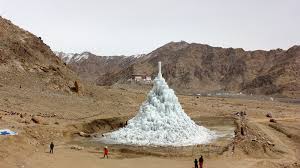Ice Stupas – Artificial Glacier:

Farmers in Gilgit-Baltistan region have successfully used ice stupas, inspired by Ladakhi engineer Sonam Wangchuk, to overcome water shortages.
- Ice stupas are artificial glaciers shaped like cones that store winter water in frozen form.
- Named after Buddhist stupas due to their iconic dome-like shape.
- Water is diverted from nearby glacial streams using gravity-driven pipelines, eliminating the need for pumps or electricity.
- At sub-zero temperatures during winter nights, water is sprayed vertically into the air, where droplets freeze mid-air and settle over a support frame.
- The ice accumulates into a cone-shaped structure (stupa), which reduces sunlight exposure and insulates the core, minimizing early melting.
- In spring, the stupa melts gradually from top to bottom, releasing water slowly to irrigate crops like apples, apricots, wheat, and barley.
- The process uses phase change, latent heat storage, heat transfer, and hydraulic gradient to create a natural, low-cost water storage solution.




